Giant Electronics T4400 FRS+GMRS User Manual
Giant Electronics Ltd FRS+GMRS
User Manual
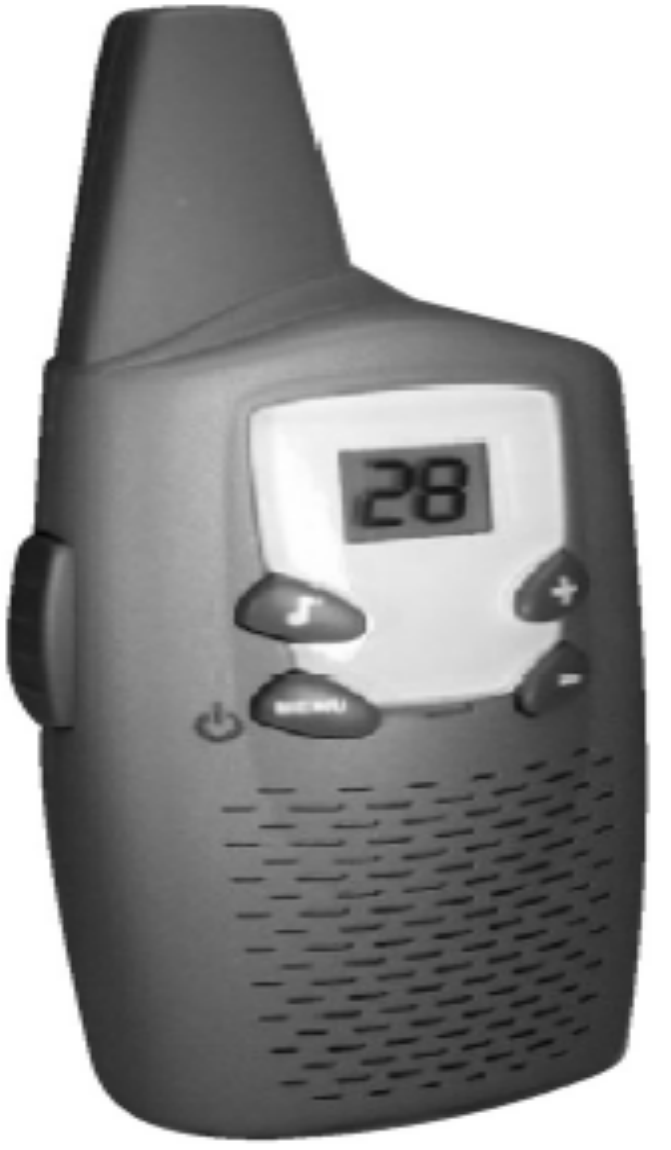
Two-Way Radio
User's Guide
manual.doc Page 1 / 10
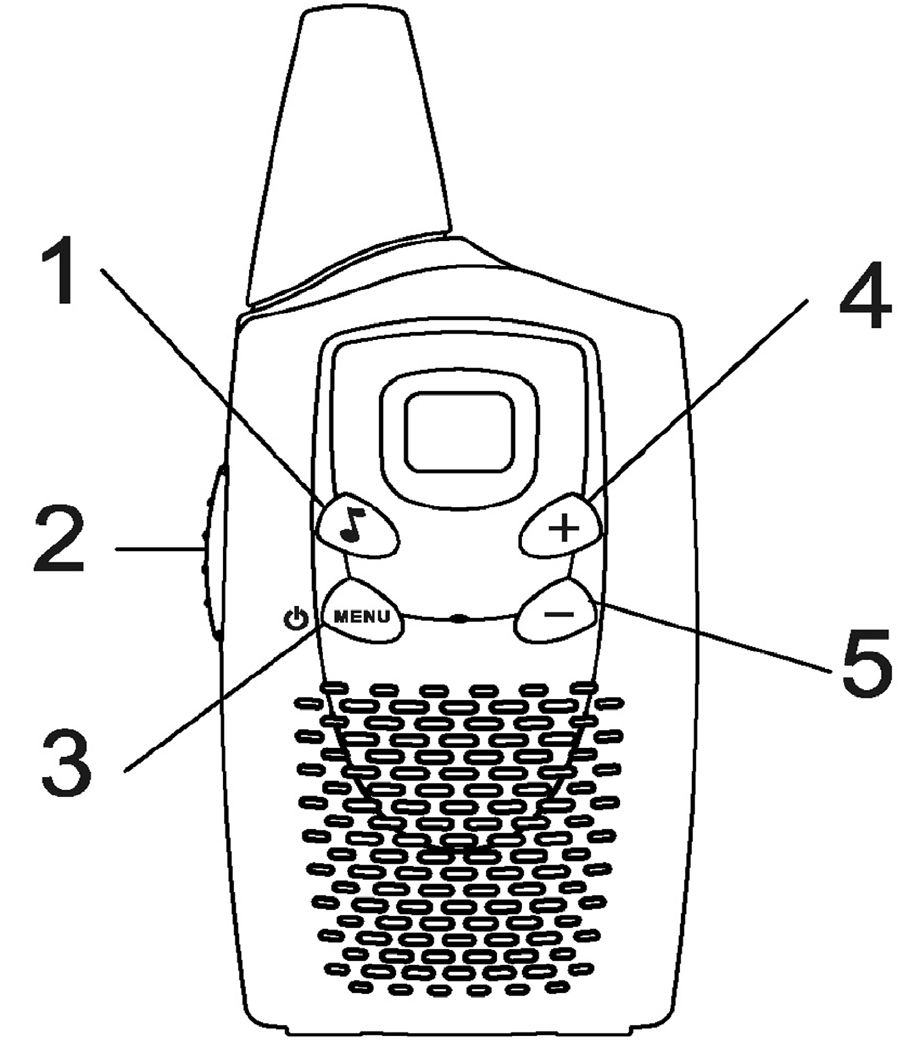
Finding the Controls
manual.doc Page 2 / 10
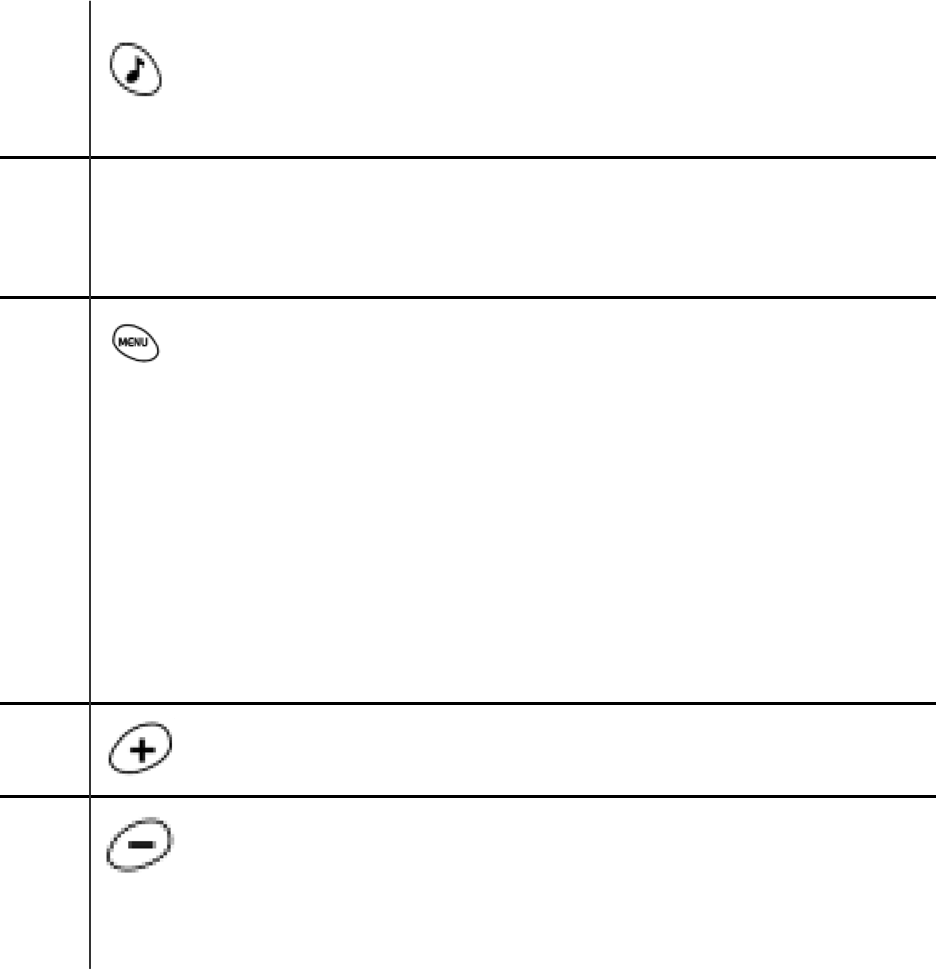
1 Short press sends call tone.
Long press maximum sends call tone 10 times, and return to
Standby Mode automatic
2 Push to Talk (PTT)
Push to transmit, release to listen. Press PTT have second limits
In menu mode, push to confirm selection.
3 Long press turns radio ON or OFF.
Short press enters menu mode:
Where:
Press one time to enters MENU mode, press or to select RF
channel.
Press two times to enter RF SCAN mode, press or to select
RF scan function ON or OFF.
Press three times to enter MONITOR mode, press or to set
volume high or low.
Press four times to exit the menu mode. It will be automatic exit
the menu mode, if you have not press any key when it in any
mode.
4 Increases volume (volume level flashes and v display).
In menu mode, increments channel (channel number flashes).
5 Decreases volume (volume level flashes and v display).
In menu mode, decreases channel (channel number flashes).
manual.doc Page 3 / 10

Installing the Batteries
Your radio uses 3 AAA alkaline batteries, and beeps
when the battery are low.
1. Turn the radio off.
2. Use a coin to wedge the battery cover open.
3. Insert batteries as shown on inside of battery
compartment.
4. Replace the battery cover.
Turning your Radio On and Off
To turn on, press and hold until a channel number
appears and the radio beeps.
To turn off, press and hold until the display goes
blank.
Adjusting the volume
Press to increase or to decrease the volume.
The volume level flashes and "v" displays.
Setting the Channel
The channel is the frequency your radio uses to transmit.
Your radio has 14 channels.
1. Briefly press and release . The channel number
manual.doc Page 4 / 10

flashes.
2. Press or to select a channel.
3. Press "PTT" to confirm.
Talking and Listening
To talk, press and hold the "PTT" button.
When you are finished talking release "PTT".
When press "PTT" over 60 second, the radio will be
return to Listening or Standby mode.
For maximum clarity, hold the radio 2 to 3 inches away
from your mouth and speak directly into microphone. do
not cover the microphone while talking.
Sending a Call Tone
A call tone alerts others you want to talk.
To send a call tone to other radios in your group,
press .
manual.doc Page 5 / 10
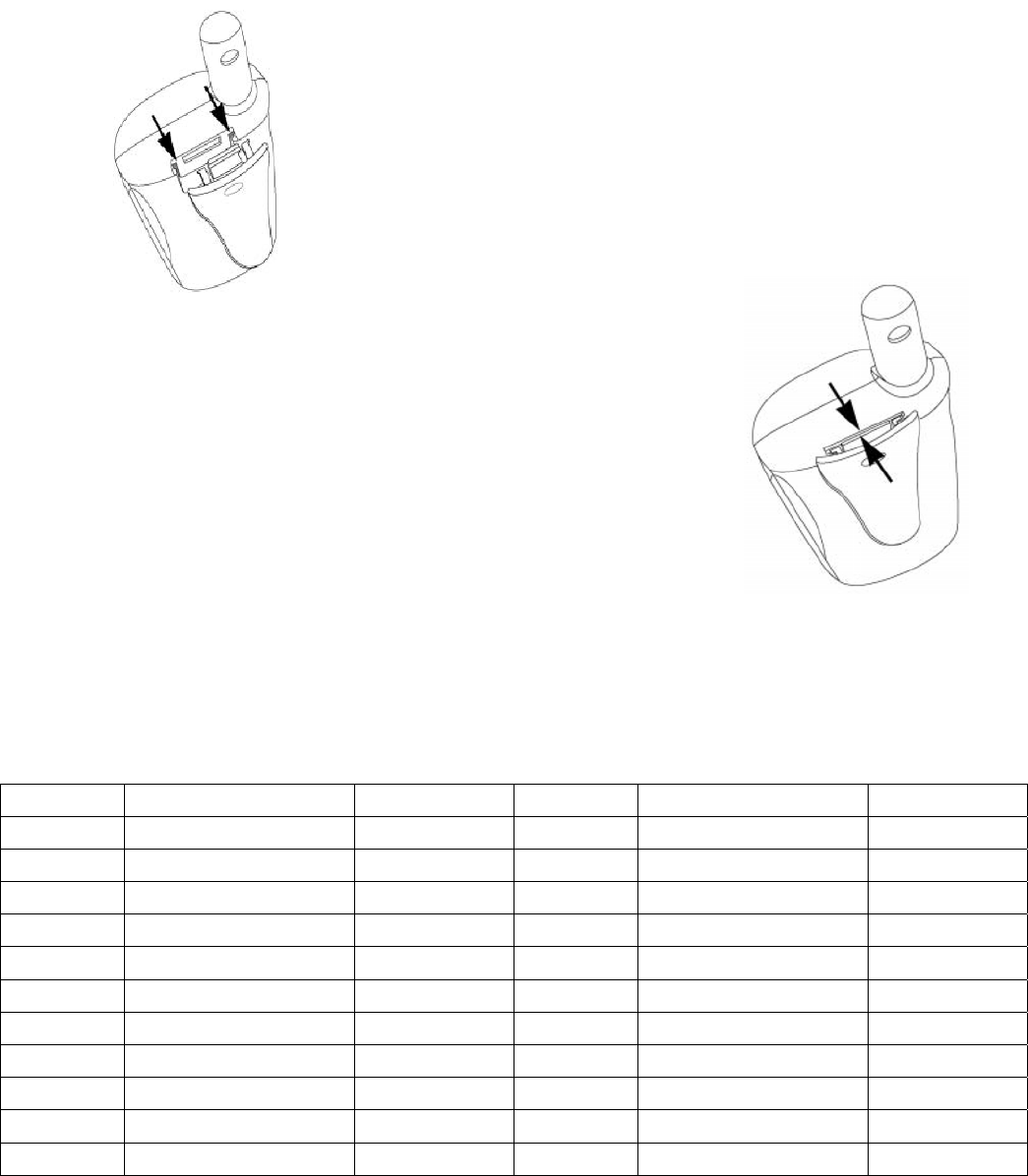
Attaching the Belt Clip (included)
Hook the belt clip into the notch at top of the
radio and slide down until it clicks into place.
To remove, squeeze the release latch
together and slide the clip up and away
from the radio.
RF Channel & Frequency
Channel Frequency Description Channel Frequency Description
1 462.5625 MHz GMRS/FRS 12 467.6625 MHz FRS
2 462.5875 MHz GMRS/FRS 13 467.6875 MHz FRS
3 462.6125 MHz GMRS/FRS 14 467.7125 MHz FRS
4 462.6375 MHz GMRS/FRS 15 462.5500 MHz GMRS
5 462.6625 MHz GMRS/FRS 16 462.5750 MHz GMRS
6 462.6875 MHz GMRS/FRS 17 462.6000 MHz GMRS
7 462.7125 MHz GMRS/FRS 18 462.6250 MHz GMRS
8 467.5625 MHz FRS 19 462.6500 MHz GMRS
9 467.5875 MHz FRS 20 462.6750 MHz GMRS
10 467.6125 MHz FRS 21 462.7000 MHz GMRS
11 467.6375 MHz FRS 22 462.7250 MHz GMRS
manual.doc Page 6 / 10

FCC Licensing Information
Your radio operates on General Mobile Radio Service (GMRS) frequencies and is subject to the
Rules and Regulations of the Federal Communications Commission (FCC). The FCC requires
that all operators using GMRS frequencies obtain a radio license before operating their
equipment. To obtain the FCC forms please request Form 605 and 159, which includes all forms
and instructions. If you wish to have the document faxed or mailed, or have questions, please
use the following contact information.
Faxed
Contact the Fax-On-
Demand System at:
Mailed
Call the FCC forms
Hotline at:
Questions
Regarding FCC license
Contact the FCC at:
1-202-418-0177 1-800-418-FORM
1-80-418-3676
1-888-CALL-FCC
1-888-225-5322
Or: http://www.fcc.gov
Changes or modifications not expressly approved by may void the user’s authority granted by
the FCC to operate this radio and should not be make. To comply with FCC requirements,
transmitter adjustments should be made only by or under the supervision of a person certified as
technically qualified to perform transmitter maintenance and repairs in the private land mobile
and fixed services as certified by an organization representative of the user of those services.
Replacement of any transmitter component (crystal, semiconductor, etc.) not authorized by the
FCC equipment authorization for this radio could violate FCC rules.
Note: Use of this radio outside the country where it was intended to be distributed is subject
to government regulations and may be prohibited.
This device complies with Part 15 of the FCC Rules. Operation is subject to the following two
conditions: (1) this device may not cause harmful interference, and (2) this device must accept any
interference received, including interference that may cause undesired operation.
NOTE: This equipment has been tested and found to comply with the limits for a Class B digital
device, pursuant to Part 15 of the FCC Rules. These limits are designed to provide reasonable
protection against harmful interference in a residential installation. This equipment generates,
uses and can radiate radio frequency energy and, if not installed and used in accordance with the
instructions, may cause harmful interference to radio communications.
However, there is no guarantee that interference will not occur in a particular installation. If this
equipment does cause harmful interference to radio or television reception, which can be
determined by turning the equipment off and on, the user is encouraged to try to correct the
interference by one or more of the following measures:
Reorient or relocate the receiving antenna.
Increase the separation between the equipment and receiver.
Connect the equipment into an outlet on a circuit different from that to which the receiver is
manual.doc Page 7 / 10
connected.
Consult the dealer or an experienced radio/TV technician for help.
Safety and General Information
Important Information on Safe and Efficient Operation Read This Information
Before Using Your Radio
The information provided in this document supersedes the general safety information in user
guides published prior to December 1, 2002.
Transmit and Receive Procedure
Your two-way radio contains a transmitter and a receiver. To control your exposure and ensure
compliance with the general population/uncontrolled environment exposure limits, always
adhere to the following procedure:
Transmit no more than 50% of the time.
To transmit (talk), press the Push to Talk (PTT) button.
To receive calls, release the PTT button.
Transmitting 50% of the time, or less, is important because the radio generates measurable RF energy
exposure only when transmitting (in terms of measuring standards compliance).
Exposure To Radio Frequency Energy
Your Our two-way radio complies with the following RF energy exposure standards and
guidelines:
United States Federal Communications Commission, Code of Federal Regulations;
47CFR part 2 sub-part J
American National Standards Institute (ANSI) / Institute of Electrical and Electronic
Engineers (IEEE) C95. 1-1992
Institute of Electrical and Electronic Engineers (IEEE) C95. 1-1999 Edition
International Commission on Non-Ionizing Radiation Protection (ICNIRP) 1998
Ministry of Health (Canada) Safety Code 6. Limits of Human Exposure to Radio
frequency Electromagnetic Fields in the Frequency Range from 3 KHz to 300 GHz, 1999
Australian Communications Authority Radio communications (Electromagnetic
Radiation – Human Exposure) Standard, 2003
ANATEL ANNEX to Resolution No. 303 of July 2, 2002 “Regulation of limitation of
exposure to electrical, magnetic and electromagnetic fields in the radio frequency range
between 9KHz and 300GHz” and “Attachment to resolution #303 from July 2, 2002”
To assure optimal radio performance and make sure human exposure to radio frequency
electromagnetic energy is within the guidelines set forth in the above standards, always adhere
manual.doc Page 8 / 10
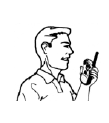
to the following procedures.
Portable Radio Operation and EME Exposure
Antenna Care
Use only the supplied or an approved replacement antenna. Unauthorized antennas,
modifications, or attachments could damage the radio and may violate FCC regulations.
DO NOT hold the antenna when the radio is “IN USE”. Holding the antenna affects the
effective range.
Two-way Radio Operation
When using your radio as a traditional two-way radio, hold the radio in a vertical
position with the microphone 1 to 2 inches (2.5 – 5 cm) away from the lips.
Body-Worn Operation
To maintain compliance with FCC/Health Canada RF exposure guidelines, if you wear a radio
on your body when transmitter, always place the radio in a Our supplied or approved clip, holder,
holster, case, or body harness for this product. Use of non-Our- approved accessories may
exceed FCC/Health Canada RF exposure guidelines.
If you do not use one of the our-supplied or approved body-wore accessories, and are not using
the radio held in the normal use position, ensure the radio and its antenna are at least 1 inch
(2.5 cm) from your body when transmitting.
Data Operation
If applicable, when using any data feature of the radio with or without an accessory cable,
position the radio and its antenna at least 1 inch (2.5 cm) from the body.
Electromagnetic Interference/Compatibility
Note: Nearly every electronic device is susceptible to electromagnetic interference (EMI) if
inadequately shielded, designed, or otherwise configured for electromagnetic compatibility.
Facilities
To avoid electromagnetic interference and/or compatibility conflicts, turn off your radio in any
facility where posted notices instruct you to do so. Hospitals or health care facilities may be
using equipment that is sensitive to external RF energy.
Aircraft
When instructed to do so, turn off your radio when on board an aircraft. Any use of a radio must
be in accordance with applicable regulations per airline crew instructions.
manual.doc Page 9 / 10
manual.doc Page 10 / 10
Medical Devices - Pacemakers
The advanced Medical Technology Association recommends that a minimum separation of 6
inches (15 cm) be maintained between a handheld wireless radio and a pacemaker. These
recommendations are consistent with the independent research by, and recommendations of the
U.S. Food and Drug Administration. Persons with pacemakers should:
ALWAYS keep the radio more than 6 inches (15cm) from their pacemaker when the radio
is turned ON.
Not carry the radio in the breast pocket.
Use the ear opposite the pacemaker to minimize the potential for interference.
Turn the radio OFF immediately if you have any reason to suspect that interference is
taking place.
Medical Devices – Hearing Aids
Some digital wireless radios may interfere with some hearing aids. In the event of such
interference, you may want to consult your hearing aid manufacturer to discuss alternatives.
Other Medical Devices
If you use any other personal medical device, consult the manufacturer of your device to
determine if it is adequately shielded from RF energy. Your physician may be able to assist you
in obtaining this information.
Safety and General Use While Driving
Check the laws and regulations on the use of radios in the area where you drive. Always obey
them. When using your radio while driving, please:
Give full attention to driving and to the road.
Use hands-free operation, if available.
Pull off the road and park before making or answering a call if driving conditions so
require.